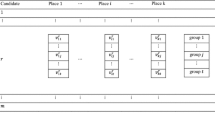Abstract
This paper proposes a new approach to allow the voters to express their preferences on a set of candidates in ranked voting systems. This approach assumes that the votes of all voters have not equal importance and there is a priority among voters. Here, voters are classified into several groups in terms of their priorities that the vote of a higher category has a greater important than that of lower category. Then, the existing ranking methods are extended to discriminate efficient candidates in our proposed model. Moreover, a new criterion to obtain a total ranking by evaluating different ranking methods based on classical voting system is given. Finally the proposed method is illustrated with an application example and shows to be effective and practical.
Similar content being viewed by others
References
Andersen, P., Petersen, N.C.: A procedure for ranking efficient units in data envelopment analysis. Manag. Sci. 39(10), 1261–1264 (1993)
Brams, S.J., Fishburn, P.C.: Voting procedures. In: Arrow, K.J., Sen, A.K., Suzumura, K. (eds.) Handbook of social, choice and welfare, vol. 1, pp. 173–236. Elsevier, Amsterdam (2002)
Cook, W.D., Kress, M.: A data envelopment model for aggregating preference rankings. Manag. Sci. 36(11), 1302–1310 (1990)
Foroughi, A.A., Tamiz, M.: An effective total ranking model for a ranked voting system. Omega 33, 491–496 (2005)
Foroughi, A.A., Jones, D.F., Tamiz, M.: A selection method for a preferential election. Appl. Math. Comput. 163, 107–116 (2005)
Green, R.H., Doyle, J.R., Cook, W.D.: Preference voting and project ranking using DEA and cross-evaluation. Eur. J. Oper. Res. 90, 461–472 (1996)
Hashimoto, A.: A ranked voting system using a DEA/AR exclusion model: a note. Eur. J. Oper. Res. 97, 600–604 (1997)
Llamazares, B., Pena, T.: Preference aggregation and DEA: an analysis of the methods proposed to discriminate efficient candidates. Eur. J. Oper. Res. 197, 714–721 (2008)
Liang, L., Wu, J., Cook, W.D., Zhu, J.: Alternative secondary goals in DEA cross-efficiency evaluation. Int. J. Prod. Econ. 113, 1025–1030 (2008)
Liu, F.H.F., Peng, H.H.: Ranking of DMUs on the DEA frontier with common weights. Comput. Oper. Res. 35(5), 1624–1637 (2008)
Noguchi, H., Ogawa, M., Ishii, H.: The appropriate total ranking method using DEA for multiple categorized purposes. J. Comput. Appl. Math. 146(1), 155–166 (2002)
Obata, T., Ishii, H.: A method for discriminating efficient candidates with ranked voting data. Eur. J. Oper. Res. 151, 233–237 (2003)
Soltanifar, M., Ebrahimnejad, A., Farrokhi, M.M.: Ranking of different ranking models using a voting model and its application in determining efficient candidates’. Int. J. Soc. Syst. Sci. 2(4), 375–389 (2010)
Wang, Y.M., Chin, K.S.: Discriminating DEA efficient candidates by considering their least relative total scores. J. Comput. Appl. Math. 206, 209–215 (2007)
Wang, N., Yi, R., Liu, D.: A solution method to the problem proposed by Wang in voting systems. J. Comput. Appl. Math. 221, 106–113 (2008)
Acknowledgments
The author would like to express their sincerest thanks to the anonymous referees for the careful reading and helpful which helped in improving throughout of this paper. Finally, the author greatly appreciates to the office of vice chancellor for research of Islamic Azad University-Qamshahr Branch, for financially support.
Author information
Authors and Affiliations
Corresponding author
Rights and permissions
About this article
Cite this article
Ebrahimnejad, A. A new approach for ranking of candidates in voting systems. OPSEARCH 49, 103–115 (2012). https://doi.org/10.1007/s12597-012-0070-9
Accepted:
Published:
Issue Date:
DOI: https://doi.org/10.1007/s12597-012-0070-9




